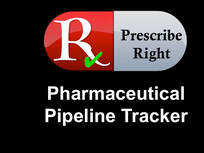|
Regulatory Update
The FDA approved tafasitamab-cxix (Monjuvi, Morphosys & Incyte), on 7/31/2020. Tafasitamab-cxix was approved in combination with lenalidomide for second-line treatment of relapsed/refractory diffuse large B-cell lymphoma. The FDA accepted the BLA for Ridgeback Biotherapeutics’ ansuvimab for the treatment of Ebola virus infections. The FDA has granted Marinus Pharmaceuticals’ ganaxolone a Rare Pediatric Disease Designation for the treatment of CDKL5 deficiency disorder, a rare refractory form of pediatric epilepsy. BMS resubmitted a BLA for idecabtagene vicleucel for the treatment of relapsed and refractory multiple myeloma. CHMP (European new drug review committee) recommended approval of Geron/Janssen’s imetelstat for the treatment of myelodysplastic syndromes. Announced Research Updates Orion announced that in the 12-week, 496 patient, Phase III REFALS trial, treatment with levosimendan did not improve the slow vital capacity in the supine position compared to placebo in patients with ALS. Levosimendan also did not improve patient functionality and survival at 48 weeks. Allergan announced that in the 12-week, 910 patient, Phase III, ADVANCE trial, monthly migraine days were reduced by 3.69 days with atogepant 10 mg, 3.86 days with 30 mg, and 4.2 days with 60 mg compared to a 2.48 days decrease with placebo in patients with four to 14 migraine days per month. In a 6-week, 477 patient, Phase III trial, viloxazine decreased the ADHD-RS-5 total score by 16.6 points with 100 mg and 17.7 points with 200 mg compared to a 10.6 point decrease with placebo in children 6 to 11 years of age with attention deficit hyperactivity disorder. Published Research Updates In a 492 patient, Phase III trial, adding pegvorhyaluronidase alfa to nab-paclitaxel plus gemcitabine resulted in overall survival of 11.2 months compared to 11.5 months with nab-paclitaxel plus gemcitabine alone in patients with hyaluronan-high metastatic pancreatic ductal adenocarcinoma. In a 195 patient Phase III trial, tivantinib did not improve progression-free survival compared to placebo in Japanese patients with highly expressed c-Met hepatocellular carcinoma with prior treatment with sorafenib. In a 12-week, 387 patient, Phase III, JADE MONO-1 trial, 24% of patients treated with abrocitinib 100 mg and 44% treated with 200 mg achieved an IGA score of clear or almost clear skin, had a 2 point or > improvement in their IGA score compared to 8% with placebo in patients with moderate to severe atopic dermatitis. A 75% or greater improvement in the Eczema Area and Severity Index (EASI-75) score was achieved by 40% of patients in the 100 mg group and by 63% in the 200 mg group compared to 12% with placebo. In a 150 day, 1,453 patient, Phase II trial, 2.6% of patients treated with nirsevimab developed medically attended RSV-associated lower respiratory tract infection compared to 9.5% with placebo in healthy infants who had been born preterm (29 weeks 0 days to 34 weeks 6 days of gestation). In a 6-week, 51 Japanese patient, Phase II trial, hemoglobin increased by 0.43 g/dL with vadadustat 150 mg, 1.13 g/dL with 300 mg, and 1.62 g/dL with 600 mg compared to a 0.47 g/dL decrease with placebo in patients with nondialysis-dependent CKD (NDD-CKD) induced anemia. In a 6-week, 60 Japanese patient, Phase II trial, hemoglobin decreased by 0.28 g/dL with vadadustat 150 mg, but increased by 0.08 g/dL with 300 mg, and 0.41 g/dL with 600 mg compared to a 1.48 g/dL decrease with placebo in patients with dialysis-dependent CKD (DD-CKD) induced anemia. By week 16, 91% of NDD-CKD patients and 71% of DD-CKD patients had achieved hemoglobin levels between 10.0 and 12.0 g/dL in both trials. GSK announced topline results from a 52-week, 271 patient, Phase III trial, where oral daprodustat was non-inferior to darbepoetin in raising mean hemoglobin levels (10.9 g/dl vs 10.8 g/dl) during weeks 40 to 52 in dialysis-dependent Japanese patients with anemia associated with chronic kidney disease. In the 40-week, 76 patient, Phase II, STAIRWAY trial, best-corrected visual acuity was improved by 9.3 letters with faricimab every 12 weeks and by 12.5 letters with every 16 weeks dosing compared to an 11.4 letter improvement with ranibizumab every 4 weeks in patients with neovascular age-related macular degeneration. Comments are closed.
|
Stay informed, subscribe to the
Prescribe Right Pharmaceutical Pipeline Tracker Latest Tweets from Prescribe Right
Archives
July 2023
|
Services |
Company |
Support |
© COPYRIGHT 2015. ALL RIGHTS RESERVED.
|


 RSS Feed
RSS Feed